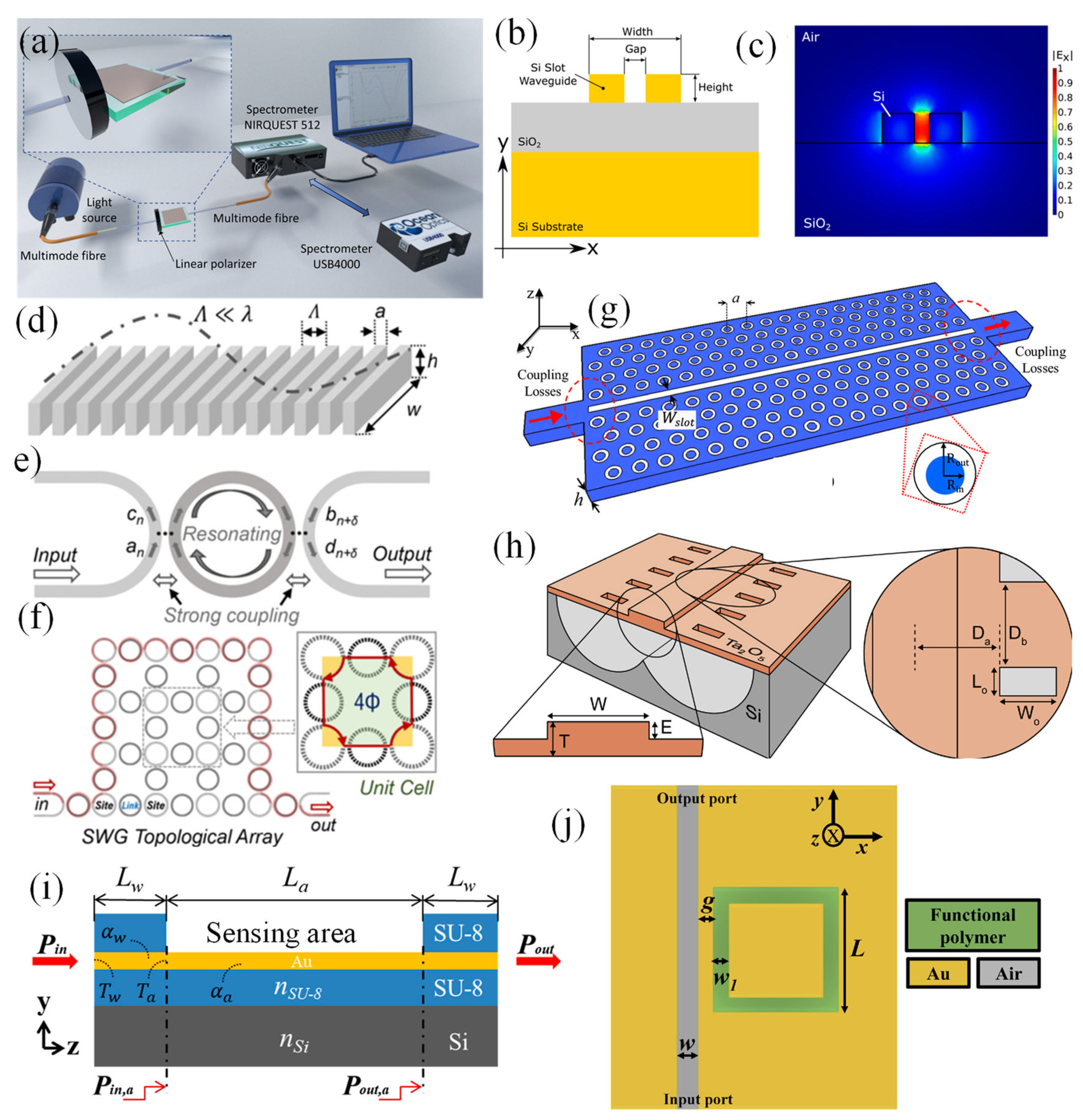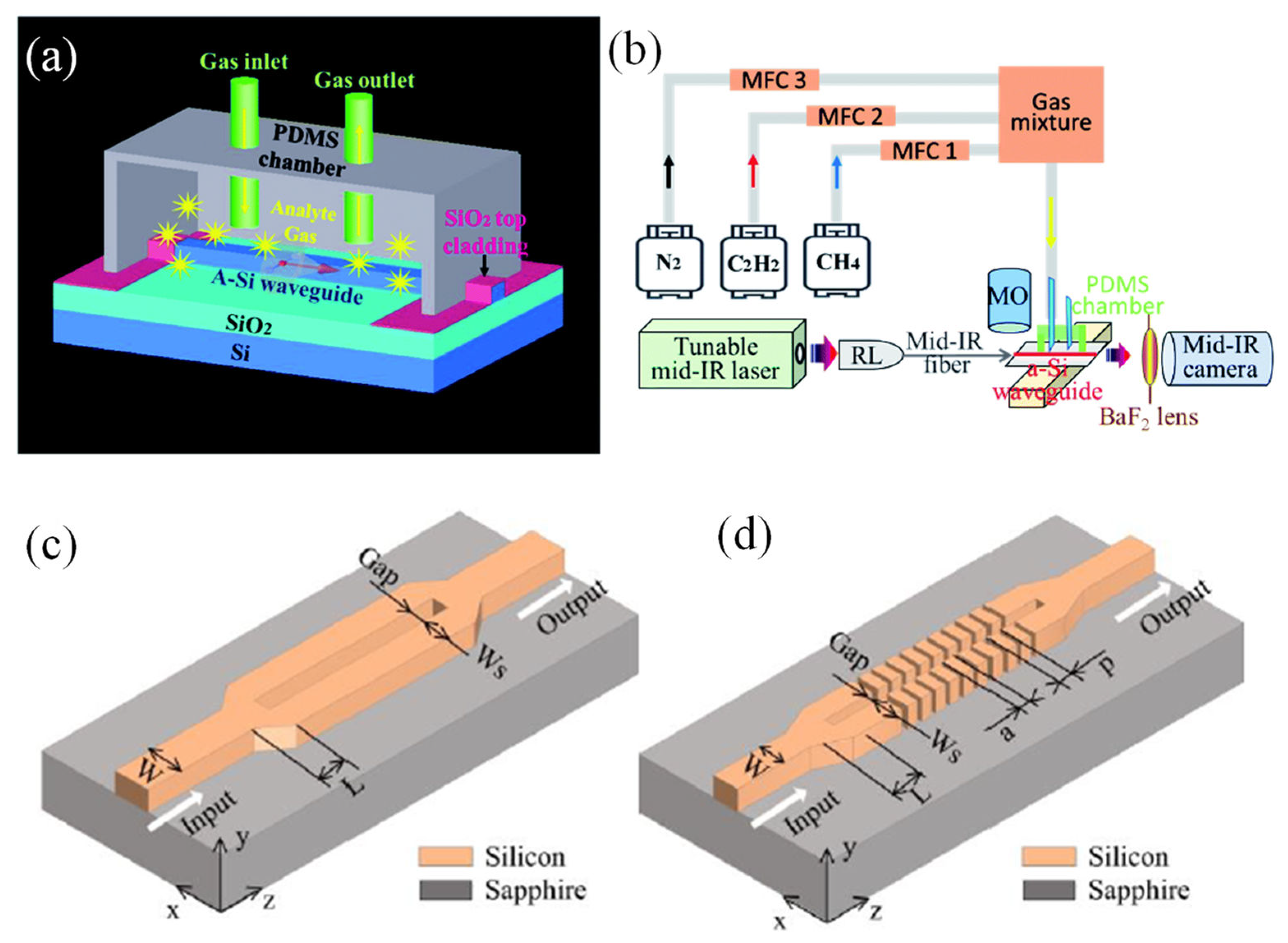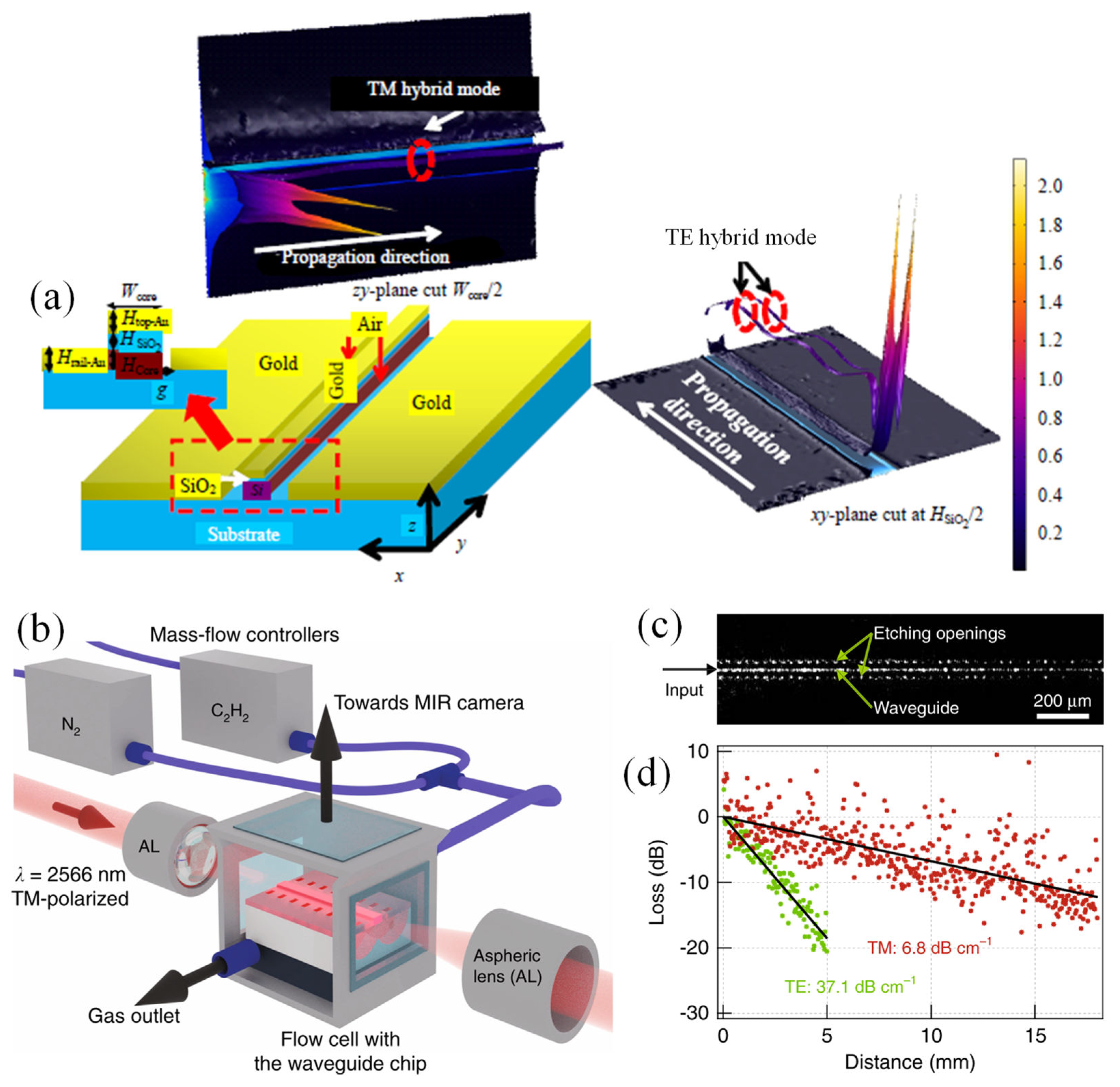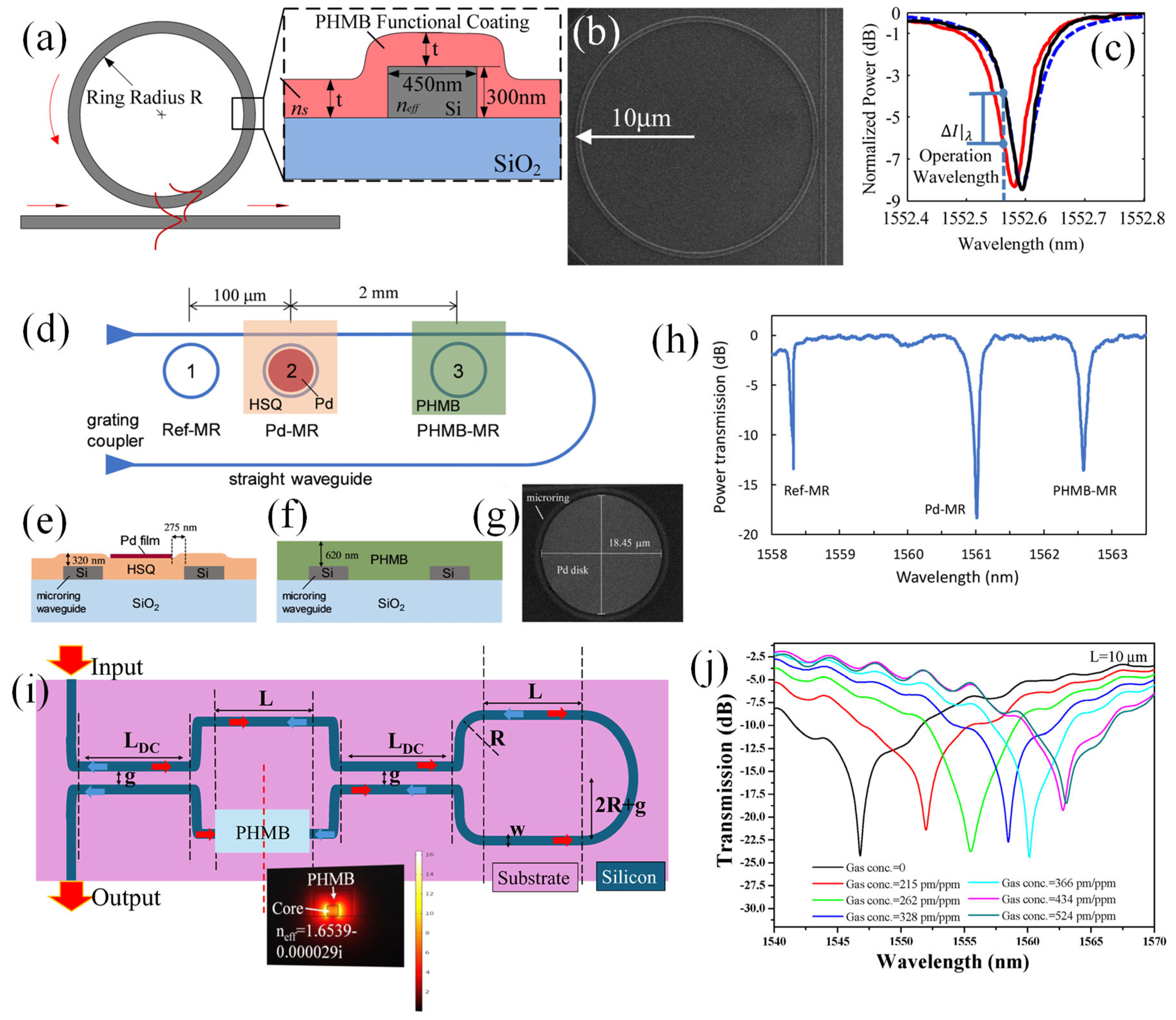Submitted:
12 June 2024
Posted:
12 June 2024
You are already at the latest version
Abstract
Keywords:
1. Introduction
2. Indoor and Outdoor Toxic Gases

3. Types of Optical WG Architectures Widely Used for Gas Sensing

4. Two Widely Employed Gas Sensing Mechanisms
4.1. Gas Sensors based on The Mechanism of EFA


4.2. Gas Sensors based on the Mechanism of Wavelength Interrogation Method

5. Other Kinds of Photonic Gas Sensors
5.1. MS-Based Gas Sensors
5.2. Optical Fiber-Based Gas Sensors
5.3. Photoacoustic Spectroscopy (PAS) Gas Sensors
6. Fabrication Methods of Integrated Photonic Sensors
7. Challenges and Prospects
8. Concluding Remarks
Author Contributions
Funding
Institutional Review Board Statement
Informed Consent Statement
Data Availability Statement
Acknowledgments
Conflicts of Interest
References
- Wang, J.; Viciano-Tudela, S.; Parra, L.; Lacuesta, R.; Lloret, J. Evaluation of Suitability of Low-Cost Gas Sensors for Monitoring Indoor and Outdoor Urban Areas. IEEE Sensors J. 2023, 23, 20968–20975. [Google Scholar] [CrossRef]
- Yang, L.; Zheng, G.; Cao, Y.; Meng, C.; Li, Y.; Ji, H.; Chen, X.; Niu, G.; Yan, J.; Xue, Y.; et al. Moisture-resistant, stretchable NOx gas sensors based on laser-induced graphene for environmental monitoring and breath analysis. Microsystems Nanoeng. 2022, 8, 1–12. [Google Scholar] [CrossRef] [PubMed]
- Lee, J.; Jung, Y.; Sung, S.-H.; Lee, G.; Kim, J.; Seong, J.; Shim, Y.-S.; Jun, S.C.; Jeon, S. High-performance gas sensor array for indoor air quality monitoring: the role of Au nanoparticles on WO3, SnO2, and NiO-based gas sensors. J. Mater. Chem. A 2020, 9, 1159–1167. [Google Scholar] [CrossRef]
- Recent Development of Gas Sensing Platforms Based on 2D Atomic Crystals | Research. Available online: https://spj.science.org/doi/10.34133/2021/9863038 (accessed on 6 June 2024).
- Sensors | Free Full-Text | The Challenges of Prolonged Gas Sensing in the Modern Urban Environment. Available online: https://www.mdpi.com/1424-8220/20/18/5189 (accessed on 6 June 2024).
- Yaqoob, U.; Younis, M.I. Chemical Gas Sensors: Recent Developments, Challenges, and the Potential of Machine Learning—A Review. Sensors 2021, 21, 2877. [Google Scholar] [CrossRef] [PubMed]
- Liu, X.; Cheng, S.; Liu, H.; Hu, S.; Zhang, D.; Ning, H. A Survey on Gas Sensing Technology. Sensors 2012, 12, 9635–9665. [Google Scholar] [CrossRef] [PubMed]
- Padvi, M.N.; Moholkar, A.V.; Prasad, S.R.; Prasad, N.R. A Critical Review on Design and Development of Gas Sensing Materials. Eng. Sci. 2021, 15, 20–37. [Google Scholar] [CrossRef]
- Eranna, G.; Joshi, B.C.; Runthala, D.P.; Gupta, R.P. Oxide Materials for Development of Integrated Gas Sensors—A Comprehensive Review. Crit. Rev. Solid State Mater. Sci. 2004, 29, 111–188. [Google Scholar] [CrossRef]
- Dhall, S.; Mehta, B.; Tyagi, A.; Sood, K. A review on environmental gas sensors: Materials and technologies. Sensors Int. 2021, 2, 100116. [Google Scholar] [CrossRef]
- Ariannejad, M.; Akbari, E.; Hanafi, E. Silicon sub-wavelength grating resonator structures for gas sensor. Superlattices Microstruct. 2020, 142, 106506. [Google Scholar] [CrossRef]
- Micromachines | Free Full-Text | Breakthrough in Silicon Photonics Technology in Telecommunications, Biosensing, and Gas Sensing. Available online: https://www.mdpi.com/2072-666X/14/8/1637 (accessed on 7 June 2024).
- Butt, M. A. ‘Loop-Terminated Mach-Zehnder Interferometer Integrated with Functional Polymer for CO2 Gas Sensing’. Preprints, May 28, 2024. [CrossRef]
- Aksnes, A. Photonic Sensors for Health and Environmental Monitoring. In Sensors for Environment, Health and Security; Baraton, M.-I., Ed.; Springer: Dordrecht, The Netherlands, 2009; pp. 191–203. [Google Scholar] [CrossRef]
- Butt, M.A.; Voronkov, G.S.; Grakhova, E.P.; Kutluyarov, R.V.; Kazanskiy, N.L.; Khonina, S.N. Environmental Monitoring: A Comprehensive Review on Optical Waveguide and Fiber-Based Sensors. Biosensors 2022, 12, 1038. [Google Scholar] [CrossRef] [PubMed]
- De, A.; Kalita, D. Bio-Fabricated Gold and Silver Nanoparticle Based Plasmonic Sensors for Detection of Environmental Pollutants: An Overview. Crit. Rev. Anal. Chem. 2023, 53, 672–688. [Google Scholar] [CrossRef] [PubMed]
- Zhou, J.; Al Husseini, D.; Li, J.; Lin, Z.; Sukhishvili, S.; Coté, G.L.; Gutierrez-Osuna, R.; Lin, P.T. Detection of volatile organic compounds using mid-infrared silicon nitride waveguide sensors. Sci. Rep. 2022, 12, 1–11. [Google Scholar] [CrossRef] [PubMed]
- Butt, M.A.; Degtyarev, S.A.; Khonina, S.N.; Kazanskiy, N.L. An evanescent field absorption gas sensor at mid-IR 3.39 μm wavelength. J. Mod. Opt. 2017, 64, 1892–1897. [Google Scholar] [CrossRef]
- Rose, J.J.; Wang, L.; Xu, Q.; McTiernan, C.F.; Shiva, S.; Tejero, J.; Gladwin, M.T. Carbon Monoxide Poisoning: Pathogenesis, Management, and Future Directions of Therapy. Am. J. Respir. Crit. Care Med. 2017, 195, 596–606. [Google Scholar] [CrossRef] [PubMed]
- Ngoc, L.T.N.; Park, D.; Lee, Y.-C. Human Health Impacts of Residential Radon Exposure: Updated Systematic Review and Meta-Analysis of Case–Control Studies. Int. J. Environ. Res. Public Heal. 2023, 20, 97. [Google Scholar] [CrossRef] [PubMed]
- IJERPH | Free Full-Text | Volatile Organic Compounds (VOCs) as Environmental Pollutants: Occurrence and Mitigation Using Nanomaterials. Available online: https://www.mdpi.com/1660-4601/18/24/13147 (accessed on 8 June 2024).
- Peterson, W.H.; Burris, R.H.; Sant, R.; Little, H.N. Toxic Gases in Silage, Production of Toxic Gas (Nitrogen Oxides) in Silage Making. J. Agric. Food Chem. 1958, 6, 121–126. [Google Scholar] [CrossRef]
- Pangeni, R.P.; Timilsina, B.; Oli, P.R.; Khadka, S.; Regmi, P.R. A multidisciplinary approach to accidental inhalational ammonia injury: A case report. Ann. Med. Surg. 2022, 82, 104741. [Google Scholar] [CrossRef] [PubMed]
- Ozone as Janus: this controversial gas can be either toxic or medically useful - Bocci - 2004 - Mediators of Inflammation - Wiley Online Library. Available online: https://onlinelibrary.wiley.com/doi/10.1080/0962935062000197083 (accessed on 8 June 2024).
- Zhou, X.; Zhou, X.; Wang, C.; Zhou, H. Environmental and human health impacts of volatile organic compounds: A perspective review. Chemosphere 2023, 313, 137489. [Google Scholar] [CrossRef]
- Jiang, J.; Chan, A.; Ali, S.; Saha, A.; Haushalter, K.J.; Lam, W.-L.M.; Glasheen, M.; Parker, J.; Brenner, M.; Mahon, S.B.; et al. Hydrogen Sulfide—Mechanisms of Toxicity and Development of an Antidote. Sci. Rep. 2016, 6, 20831. [Google Scholar] [CrossRef]
- Anjana, N.; Amarnath, A.; Nair, M.H. Toxic hazards of ammonia release and population vulnerability assessment using geographical information system. J. Environ. Manag. 2018, 210, 201–209. [Google Scholar] [CrossRef] [PubMed]
- Ho, W.F.; Chan, H.P.; Yang, K.L. Planar Optical Waveguide Platform for Gas Sensing Using Liquid Crystal. IEEE Sensors J. 2013, 13, 2521–2522. [Google Scholar] [CrossRef]
- Vitoria, I.; Gallego, E.E.; Melendi-Espina, S.; Hernaez, M.; Zamarreño, C.R.; Matías, I.R. Gas Sensor Based on Lossy Mode Resonances by Means of Thin Graphene Oxide Films Fabricated onto Planar Coverslips. Sensors 2023, 23, 1459. [Google Scholar] [CrossRef] [PubMed]
- Zheng, L.; Keppler, N.; Zhang, H.; Behrens, P.; Roth, B. Planar Polymer Optical Waveguide with Metal-Organic Framework Coating for Carbon Dioxide Sensing. Adv. Mater. Technol. 2022, 7, 2200395. [Google Scholar] [CrossRef]
- Dominguez, I.; Del Villar, I.; Fuentes, O.; Corres, J.M.; Matias, I.R. Dually nanocoated planar waveguides towards multi-parameter sensing. Sci. Rep. 2021, 11, 1–8. [Google Scholar] [CrossRef]
- Barrios, C.A.; Bañuls, M.J.; González-Pedro, V.; Gylfason, K.B.; Sánchez, B.; Griol, A.; Maquieira, A.; Sohlström, H.; Holgado, M.; Casquel, R. Label-free optical biosensing with slot-waveguides. Opt. Lett. 2008, 33, 708–710. [Google Scholar] [CrossRef] [PubMed]
- Butt, M.A.; Piramidowicz, R. Standard slot waveguide and double hybrid plasmonic waveguide configurations for enhanced evanescent field absorption methane gas sensing. Photon- Lett. Pol. 2022, 14, 10–12. [Google Scholar] [CrossRef]
- Passaro, V.M.N.; Dell’olio, F.; Ciminelli, C.; Armenise, M.N. Efficient Chemical Sensing by Coupled Slot SOI Waveguides. Sensors 2009, 9, 1012–1032. [Google Scholar] [CrossRef]
- Barrios, C.A. Optical Slot-Waveguide Based Biochemical Sensors. Sensors 2009, 9, 4751–4765. [Google Scholar] [CrossRef]
- Ranacher, C.; Consani, C.; Jannesari, R.; Grille, T.; Jakoby, B. Numerical Investigations of Infrared Slot Waveguides for Gas Sensing. Proceedings 2018, 2, 13. [Google Scholar] [CrossRef]
- Torrijos-Morán, L.; Griol, A.; García-Rupérez, J. Experimental study of subwavelength grating bimodal waveguides as ultrasensitive interferometric sensors. Opt. Lett. 2019, 44, 4702–4705. [Google Scholar] [CrossRef] [PubMed]
- Awasthi, K.; Malviya, N.; Kumar, A. Silicon Subwavelength Grating Slot Waveguide based Optical Sensor for Label Free Detection of Fluoride Ion in Water. IETE Tech. Rev. 2023, 41, 341–352. [Google Scholar] [CrossRef]
- Kazanskiy, N.L.; Khonina, S.N.; Butt, M.A. Subwavelength Grating Double Slot Waveguide Racetrack Ring Resonator for Refractive Index Sensing Application. Sensors 2020, 20, 3416. [Google Scholar] [CrossRef] [PubMed]
- Tu, Z.; Gao, D.; Zhang, M.; Zhang, D. High-sensitivity complex refractive index sensing based on Fano resonance in the subwavelength grating waveguide micro-ring resonator. Opt. Express 2017, 25, 20911–20922. [Google Scholar] [CrossRef]
- Arledge, K.E.; Uchoa, B.; Zou, Y.; Weng, B. Topological sensing with photonic arrays of resonant circular waveguides. Phys. Rev. Res. 2021, 3, 033106. [Google Scholar] [CrossRef]
- Si, G.; Teo, E.J.; Bettiol, A.A.; Teng, J.; Danner, A.J. Suspended slab and photonic crystal waveguides in lithium niobate. J. Vac. Sci. Technol. B 2010, 28, 316–320. [Google Scholar] [CrossRef]
- Butt, M.; Khonina, S.; Kazanskiy, N. Recent advances in photonic crystal optical devices: A review. Opt. Laser Technol. 2021, 142, 107265. [Google Scholar] [CrossRef]
- Kassa-Baghdouche, L.; Cassan, E. Sensitivity analysis of ring-shaped slotted photonic crystal waveguides for mid-infrared refractive index sensing. Opt. Quantum Electron. 2019, 51, 328. [Google Scholar] [CrossRef]
- Rostamian, A.; Midkiff, J.; Yoo, K.M.; Cheng, Y.; Chakravarty, S.; Chen, R. 2019 IEEE Photonics Society Summer Topical Meeting Series (SUM). In 2019 IEEE Photonics Society Summer Topical Meeting Series (SUM); IEEE: Ft. Lauderdale, FL, USA, 2019; pp. 1–2. [Google Scholar] [CrossRef]
- Peng, Z.; Huang, Y.; Zheng, K.; Zheng, C.; Pi, M.; Zhao, H.; Ji, J.; Min, Y.; Liang, L.; Song, F.; et al. Slow-light-enhanced on-chip 1D and 2D photonic crystal waveguide gas sensing in near-IR with an ultrahigh interaction factor. Photon- Res. 2023, 11, 1647–1656. [Google Scholar] [CrossRef]
- Goyal, A.K.; Pal, S. Design and simulation of high sensitive photonic crystal waveguide sensor. Optik 2015, 126, 240–243. [Google Scholar] [CrossRef]
- Butt, M.A.; Kazansky, N.L. SOI Suspended membrane waveguide at 3.39 μm for gas sensing application. Photon- Lett. Pol. 2020, 12, 67–69. [Google Scholar] [CrossRef]
- Vlk, M.; Datta, A.; Alberti, S.; Murugan, G.S.; Aksnes, A.; Jágerská, J. Free-standing tantalum pentoxide waveguides for gas sensing in the mid-infrared. Opt. Mater. Express 2021, 11, 3111–3124. [Google Scholar] [CrossRef]
- Yoo, K.M.; Midkiff, J.; Rostamian, A.; Chakravarty, S.; Chen, R.T. Suspended Membrane InGaAs Photonic Crystal Waveguides for ammonia sensing at λ=6.15μm. In Conference on Lasers and Electro-Optics (2019), paper STh1F.6; Optica Publishing Group, 2019; p. STh1F.6. [Google Scholar] [CrossRef]
- Yoo, K.M.; Midkiff, J.; Rostamian, A.; Chung, C.-J.; Dalir, H.; Chen, R.T. InGaAs Membrane Waveguide: A Promising Platform for Monolithic Integrated Mid-Infrared Optical Gas Sensor. ACS Sensors 2020, 5, 861–869. [Google Scholar] [CrossRef] [PubMed]
- Xu, Y.; Wang, F.; Gao, Y.; Zhang, D.; Sun, X.; Berini, P. Straight Long-Range Surface Plasmon Polariton Waveguide Sensor Operating at λ0 = 850 nm. Sensors 2020, 20, 2507. [Google Scholar] [CrossRef] [PubMed]
- Khonina, S.; Kazanskiy, N.; Butt, M.A.; Kazmierczak, A.; Piramidowicz, R. Plasmonic sensor based on metal-insulator-metal waveguide square ring cavity filled with functional material for the detection of CO2 gas. Opt. Express 2021, 29, 16584–16594. [Google Scholar] [CrossRef] [PubMed]
- Butt, M.; Khonina, S.; Kazanskiy, N. Plasmonics: A Necessity in the Field of Sensing-A Review (Invited). Fiber Integr. Opt. 2021, 40, 14–47. [Google Scholar] [CrossRef]
- Kazanskiy, N.; Khonina, S.; Butt, M. Plasmonic sensors based on Metal-insulator-metal waveguides for refractive index sensing applications: A brief review. Phys. E: Low-dimensional Syst. Nanostructures 2020, 117, 113798. [Google Scholar] [CrossRef]
- Butt, M.A.; Shahbaz, M.; Piramidowicz, R. Racetrack Ring Resonator Integrated with Multimode Interferometer Structure Based on Low-Cost Silica–Titania Platform for Refractive Index Sensing Application. Photonics 2023, 10, 978. [Google Scholar] [CrossRef]
- Kazanskiy, N.L.; Butt, M.A.; Khonina, S.N. Carbon Dioxide Gas Sensor Based on Polyhexamethylene Biguanide Polymer Deposited on Silicon Nano-Cylinders Metasurface. Sensors 2021, 21, 378. [Google Scholar] [CrossRef]
- Butt, M.; Kazanskiy, N.; Khonina, S. On-chip symmetrically and asymmetrically transformed plasmonic Bragg grating formation loaded with a functional polymer for filtering and CO2 gas sensing applications. Measurement 2022, 201, 111694. [Google Scholar] [CrossRef]
- Optical Fiber Fabry–Perot Interferometric CO2 Gas Sensor Using Guanidine Derivative Polymer Functionalized Layer | IEEE Journals & Magazine | IEEE Xplore. Available online: https://ieeexplore.ieee.org/document/8249792/ (accessed on 4 May 2024).
- Kazanskiy, N.L.; Khonina, S.N.; Butt, M.A. Advancement in Silicon Integrated Photonics Technologies for Sensing Applications in Near-Infrared and Mid-Infrared Region: A Review. Photonics 2022, 9, 331. [Google Scholar] [CrossRef]
- Song, Y.; Li, B.; Zhang, H.; Li, M.; Li, Q.; He, J.-J. Silicon Waveguide Sensors for Carbon Dioxide Gas Sensing in the Mid-Infrared Region. Photonics 2023, 10, 120. [Google Scholar] [CrossRef]
- Butt, M.A. Dielectric Waveguide-Based Sensors with Enhanced Evanescent Field: Unveiling the Dynamic Interaction with the Ambient Medium for Biosensing and Gas-Sensing Applications—A Review. Photonics 2024, 11, 198. [Google Scholar] [CrossRef]
- Khonina, S.N.; Kazanskiy, N.L.; Butt, M.A. Evanescent Field Ratio Enhancement of a Modified Ridge Waveguide Structure for Methane Gas Sensing Application. IEEE Sensors J. 2020, 20, 8469–8476. [Google Scholar] [CrossRef]
- Consani, C.; Ranacher, C.; Tortschanoff, A.; Grille, T.; Irsigler, P.; Jakoby, B. Evanescent-Wave Gas Sensing Using an Integrated Thermal Light Source. Proceedings 2017, 1, 4. [Google Scholar] [CrossRef]
- A Butt, M.; Khonina, S.N.; Kazanskiy, N.L. Enhancement of evanescent field ratio in a silicon strip waveguide by incorporating a thin metal film. Laser Phys. 2019, 29, 076202. [Google Scholar] [CrossRef]
- Chandra, V.; Ranjan, R. Performance analysis of different slot waveguide structures for evanescent field based gas sensor applications. Opt. Quantum Electron. 2021, 53, 1–15. [Google Scholar] [CrossRef]
- Vlk, M.; Datta, A.; Alberti, S.; Yallew, H.D.; Mittal, V.; Murugan, G.S.; Jágerská, J. Extraordinary evanescent field confinement waveguide sensor for mid-infrared trace gas spectroscopy. Light. Sci. Appl. 2021, 10, 1–7. [Google Scholar] [CrossRef]
- Ranacher, C.; Consani, C.; Vollert, N.; Tortschanoff, A.; Bergmeister, M.; Grille, T.; Jakoby, B. Characterization of Evanescent Field Gas Sensor Structures Based on Silicon Photonics. IEEE Photon- J. 2018, 10, 1–14. [Google Scholar] [CrossRef]
- Ultrasensitive Indium Phosphide Nanomembrane Wearable Gas Sensors - Wei - ENERGY & ENVIRONMENTAL MATERIALS - Wiley Online Library. Available online: https://onlinelibrary.wiley.com/doi/full/10.1002/eem2.12763 (accessed on 7 June 2024).
- Rosborough, V.; Fridlander, J.; Sang, F.; Gambini, F.; Brunelli, S.T.; Chen, J.R.; Kawa, S.; Numata, K.; Stephen, M.; Coldren, L.; et al. OSA Optical Sensors and Sensing Congress 2021 (AIS, FTS, HISE, SENSORS, ES) (2021), paper ETu6D.2; Optica Publishing Group, 2021; p. ETu6D.2. [Google Scholar]
- Shahriar, R.; Hassan, O.; Alam, K. Adsorption of gas molecules on buckled GaAs monolayer: a first-principles study. RSC Adv. 2022, 12, 16732–16744. [Google Scholar] [CrossRef]
- Xie, K.-H.; Zhang, X.; Zhang, X.-W.; Jin, H.; Jian, J.-W. A slot microring sensor with feedback spiral waveguide for trace gas CH4 sensing in mid-infrared region. Optoelectron. Lett. 2019, 15, 1–5. [Google Scholar] [CrossRef]
- Germanium-on-Glass waveguides for Mid-IR photonics. Available online: https://opg.optica.org/abstract.cfm?uri=photonics-2016-Th3A.18 (accessed on 31 January 2024).
- Mid-infrared photonics in silicon and germanium | Nature Photonics. Available online: https://www.nature.com/articles/nphoton.2010.171 (accessed on 31 January 2024).
- Verification of Ge-on-insulator structure for a mid-infrared photonics platform. Available online: https://opg.optica.org/ome/fulltext.cfm?uri=ome-8-2-440&id=380890 (accessed on 31 January 2024).
- Sensors | Free Full-Text | Development and Measurements of a Mid-Infrared Multi-Gas Sensor System for CO, CO2 and CH4 Detection. Available online: https://www.mdpi.com/1424-8220/17/10/2221 (accessed on 31 January 2024).
- An integrated optic ethanol vapor sensor based on a silicon-on-insulator microring resonator coated with a porous ZnO film. Available online: https://opg.optica.org/oe/fulltext.cfm?uri=oe-18-11-11859&id=199658 (accessed on 31 January 2024).
- Jin, T.; Zhou, J.; Lin, P.T. Real-time and non-destructive hydrocarbon gas sensing using mid-infrared integrated photonic circuits. RSC Adv. 2020, 10, 7452–7459. [Google Scholar] [CrossRef]
- Kazanskiy, N.L.; Khonina, S.N.; Butt, M.A. Polarization-Insensitive Hybrid Plasmonic Waveguide Design for Evanescent Field Absorption Gas Sensor. Photon- Sensors 2021, 11, 279–290. [Google Scholar] [CrossRef]
- Mi, G.; Horvath, C.; Van, V. Silicon photonic dual-gas sensor for H_2 and CO_2 detection. Opt. Express 2017, 25, 16250–16259. [Google Scholar] [CrossRef]
- Wang, W.-Y.; Hu, H.-W.; Chiou, J.-C.; Yung, K.-F.; Kan, C.-W. Poly(hexamethylene biguanide) hydrochloride (PHMB)-based materials: synthesis, modification, properties, determination, and application. Polym. Chem. 2023, 14, 5226–5252. [Google Scholar] [CrossRef]
- Silicon microring refractometric sensor for atmospheric CO2 gas monitoring. Available online: https://opg.optica.org/oe/fulltext.cfm?uri=oe-24-2-1773&id=335762 (accessed on 4 May 2024).
- Polyaniline Nanofiber Gas Sensors: Examination of Response Mechanisms | Nano Letters. Available online: https://pubs.acs.org/doi/10.1021/nl035122e (accessed on 7 June 2024).
- Sensors | Free Full-Text | Gas Sensor with Different Morphology of PANI Layer. Available online: https://www.mdpi.com/1424-8220/23/3/1106 (accessed on 7 June 2024).
- Fratoddi, I.; Venditti, I.; Cametti, C.; Russo, M.V. Chemiresistive polyaniline-based gas sensors: A mini review. Sensors Actuators B: Chem. 2015, 220, 534–548. [Google Scholar] [CrossRef]
- Jain, A.; Nabeel, A.N.; Bhagwat, S.; Kumar, R.; Sharma, S.; Kozak, D.; Hunjet, A.; Kumar, A.; Singh, R. Fabrication of polypyrrole gas sensor for detection of NH3 using an oxidizing agent and pyrrole combinations: Studies and characterizations. Heliyon 2023, 9, e17611. [Google Scholar] [CrossRef]
- Li, W.; Lefferts, M.J.; Armitage, B.I.; Murugappan, K.; Castell, M.R. Polypyrrole Percolation Network Gas Sensors: Improved Reproducibility through Conductance Monitoring during Polymer Growth. ACS Appl. Polym. Mater. 2022, 4, 2536–2543. [Google Scholar] [CrossRef]
- Bhatt, C.M.; Jampana, N. Comparative studies on electrical properties of Polypyrrole based gas sensor. In 2011 IEEE Sensors Applications Symposium; IEEE: San Antonio, TX, USA, 2011; pp. 131–135. [Google Scholar]
- Nagashima, K.; Kamaya, M.; Ishii, E. Electrochemical gas sensors using electrolytic films of poly(ethylene oxide)/Zn, Cu, Ni trifluoromethane sulphonates for flow injection analysis of nitrogen dioxide. Sensors Actuators B: Chem. 1992, 9, 149–154. [Google Scholar] [CrossRef]
- Nagashima, K.; Meguro, K.; Hobo, T. A galvanic gas sensor using poly (ethylene oxide) complex of silver trifluoromethane sulphonate electrolyte. Anal. Bioanal. Chem. 1990, 336, 571–574. [Google Scholar] [CrossRef]
- Kazanskiy, N.L.; Khonina, S.N.; Butt, M.A. Recent Development in Metasurfaces: A Focus on Sensing Applications. Nanomaterials 2023, 13, 118. [Google Scholar] [CrossRef]
- Chatterjee, S.; Shkondin, E.; Takayama, O.; Fisher, A.; Fraiwan, A.; Gurkan, U.A.; Lavrinenko, A.V.; Strangi, G. Hydrogen gas sensing using aluminum doped ZnO metasurfaces. Nanoscale Adv. 2020, 2, 3452–3459. [Google Scholar] [CrossRef]
- Butt, M.; Khonina, S.; Kazanskiy, N.; Piramidowicz, R. Hybrid metasurface perfect absorbers for temperature and biosensing applications. Opt. Mater. 2022, 123, 111906. [Google Scholar] [CrossRef]
- Nugroho, F.A.A.; Bai, P.; Darmadi, I.; Castellanos, G.W.; Fritzsche, J.; Langhammer, C.; Rivas, J.G.; Baldi, A. Inverse designed plasmonic metasurface with parts per billion optical hydrogen detection. Nat. Commun. 2022, 13, 5737. [Google Scholar] [CrossRef]
- Polymers | Free Full-Text | Towards Highly Efficient Nitrogen Dioxide Gas Sensors in Humid and Wet Environments Using Triggerable-Polymer Metasurfaces. Available online: https://www.mdpi.com/2073-4360/15/3/545 (accessed on 8 June 2024).
- Kim, I.; Kim, W.-S.; Kim, K.; Ansari, M.A.; Mehmood, M.Q.; Badloe, T.; Kim, Y.; Gwak, J.; Lee, H.; Kim, Y.-K.; et al. Holographic metasurface gas sensors for instantaneous visual alarms. Sci. Adv. 2021, 7, eabe9943. [Google Scholar] [CrossRef]
- Sensors | Free Full-Text | Metasurfaces for Sensing Applications: Gas, Bio and Chemical. Available online: https://www.mdpi.com/1424-8220/22/18/6896 (accessed on 6 June 2024).
- Kazanskiy, N.L.; Khonina, S.N.; Butt, M.A. Metasurfaces: Shaping the future of photonics. Sci. Bull. 2024. [Google Scholar] [CrossRef]
- Warken, F.; Vetsch, E.; Meschede, D.; Sokolowski, M.; Rauschenbeutel, A. Ultra-sensitive surface absorption spectroscopy using sub-wavelength diameter optical fibers. Opt. Express 2007, 15, 11952–11958. [Google Scholar] [CrossRef]
- Potyrailo, R.A.; Hobbs, S.E.; Hieftje, G.M. Near-Ultraviolet Evanescent-Wave Absorption Sensor Based on a Multimode Optical Fiber. Anal. Chem. 1998, 70, 1639–1645. [Google Scholar] [CrossRef]
- Benito-Peña, E.; Valdés, M.G.; Glahn-Martínez, B.; Moreno-Bondi, M.C. Fluorescence based fiber optic and planar waveguide biosensors. A review. Anal. Chim. Acta 2016, 943, 17–40. [Google Scholar] [CrossRef]
- Epstein, J.R.; Walt, D.R. Fluorescence-based fibre optic arrays: a universal platform for sensing. Chem. Soc. Rev. 2003, 32, 203–214. [Google Scholar] [CrossRef]
- Ding, L.; Gong, P.; Xu, B.; Ding, Q. An Optical Fiber Sensor Based on Fluorescence Lifetime for the Determination of Sulfate Ions. Sensors 2021, 21, 954. [Google Scholar] [CrossRef]
- Thompson, R. B. Fluorescence-Based Fiber-Optic Sensors. In Topics in Fluorescence Spectroscopy: Principles; Lakowicz, J. R., Ed.; Springer US: Boston, MA, 2002; pp. 345–365. [Google Scholar] [CrossRef]
- Wolfbeis, O.S.; Posch, H.E. Fibre-optic fluorescing sensor for ammonia. Anal. Chim. Acta 1986, 185, 321–327. [Google Scholar] [CrossRef]
- Zhang, C.; Liu, Z.; Cai, C.; Yang, Z.; Qi, Z.-M. Surface plasmon resonance gas sensor with a nanoporous gold film. Opt. Lett. 2022, 47, 4155–4158. [Google Scholar] [CrossRef]
- Sensors | Free Full-Text | Research Advances on Fiber-Optic SPR Sensors with Temperature Self-Compensation. Available online: https://www.mdpi.com/1424-8220/23/2/644 (accessed on 8 June 2024).
- Sensors | Free Full-Text | A Review: Application and Implementation of Optic Fibre Sensors for Gas Detection. Available online: https://www.mdpi.com/1424-8220/21/20/6755 (accessed on 8 June 2024).
- Chen, X.; Gan, L.; Guo, X. Optical Fiber-Based Gas Sensing for Early Warning of Thermal Runaway in Lithium-Ion Batteries. Adv. Sens. Res. 2023, 2, 2300055. [Google Scholar] [CrossRef]
- Photoacoustic Spectroscopy Gas Detection Technology Research Progress - Shuidong Xiong, Xiangyu Yin, Qi Wang, Ji Xia, Ziqiang Chen, Hongwei Lei, Xin Yan, Aisong Zhu, Fengmei Qiu, Binhai Chen, Qiaoyun Wang, Lei Zhang, Keke Zhang, 2024. Available online: https://journals.sagepub.com/doi/10.1177/00037028231208712 (accessed on 8 June 2024).
- Yang, T.; Chen, W.; Wang, P. A review of all-optical photoacoustic spectroscopy as a gas sensing method. Appl. Spectrosc. Rev. 2021, 56, 143–170. [Google Scholar] [CrossRef]
- Zhang, X.; Liu, L.; Zhang, L.; Yin, X.; Huan, H.; Zhang, L.; Shao, X. A compact portable photoacoustic spectroscopy sensor for multiple trace gas detection. J. Appl. Phys. 2022, 131, 174501. [Google Scholar] [CrossRef]
- Qiao, S.; He, Y.; Sun, H.; Patimisco, P.; Sampaolo, A.; Spagnolo, V.; Ma, Y. Ultra-highly sensitive dual gases detection based on photoacoustic spectroscopy by exploiting a long-wave, high-power, wide-tunable, single-longitudinal-mode solid-state laser. Light. Sci. Appl. 2024, 13, 1–16. [Google Scholar] [CrossRef]
- Qiao, S.; Qu, Y.; Ma, Y.; He, Y.; Wang, Y.; Hu, Y.; Yu, X.; Zhang, Z.; Tittel, F.K. A Sensitive Carbon Dioxide Sensor Based on Photoacoustic Spectroscopy with a Fixed Wavelength Quantum Cascade Laser. Sensors 2019, 19, 4187. [Google Scholar] [CrossRef] [PubMed]
- Wang, Z.L.; Tian, C.W.; Liu, Q.; Chang, J.; Zhang, Q.D.; Zhu, C.G. Wavelength modulation technique-based photoacoustic spectroscopy for multipoint gas sensing. Appl. Opt. 2018, 57, 2909–2914. [Google Scholar] [CrossRef]
- Elia, A.; Di Franco, C.; Lugarà, P.M.; Scamarcio, G. Photoacoustic Spectroscopy with Quantum Cascade Lasers for Trace Gas Detection. Sensors 2006, 6, 1411–1419. [Google Scholar] [CrossRef]
- Patimisco, P.; Scamarcio, G.; Tittel, F.K.; Spagnolo, V. Quartz-Enhanced Photoacoustic Spectroscopy: A Review. Sensors 2014, 14, 6165–6206. [Google Scholar] [CrossRef]
- Butt, M.A. Integrated Optics: Platforms and Fabrication Methods. Encyclopedia 2023, 3, 824–838. [Google Scholar] [CrossRef]
- Liaros, N.; Fourkas, J.T. Ten years of two-color photolithography [Invited]. Opt. Mater. Express 2019, 9, 3006–3020. [Google Scholar] [CrossRef]
- Crowell, J.E. Chemical methods of thin film deposition: Chemical vapor deposition, atomic layer deposition, and related technologies. J. Vac. Sci. Technol. A 2003, 21, S88–S95. [Google Scholar] [CrossRef]
- Joyce, B.A. Molecular beam epitaxy-fundamentals and current status. Contemp. Phys. 1990, 31, 195–197. [Google Scholar] [CrossRef]
- Butt, M.A.; Tyszkiewicz, C.; Karasiński, P.; Zięba, M.; Hlushchenko, D.; Baraniecki, T.; Kazmierczak, A.; Piramidowicz, R.; Guzik, M.; Bachmatiuk, A. Development of a low-cost silica-titania optical platform for integrated photonics applications. Opt. Express 2022, 30, 23678–23694. [Google Scholar] [CrossRef]
- Butt, M.A.; Tyszkiewicz, C.; Wojtasik, K.; Karasiński, P.; Kaźmierczak, A.; Piramidowicz, R. Subwavelength Grating Waveguide Structures Proposed on the Low-Cost Silica–Titania Platform for Optical Filtering and Refractive Index Sensing Applications. Int. J. Mol. Sci. 2022, 23, 6614. [Google Scholar] [CrossRef] [PubMed]
- Chen, Y.F. Nanofabrication by electron beam lithography and its applications: A review. Microelectron. Eng. 2015, 135, 57–72. [Google Scholar] [CrossRef]
- Hohn, F.J. Electron beam lithography: Its applications. J. Vac. Sci. Technol. B: Microelectron. Nanometer Struct. 1989, 7, 1405–1411. [Google Scholar] [CrossRef]
- Ferstl, M. Reactive ion etching: a versatile fabrication technique for micro-optical elements. In Diffractive Optics and Micro-Optics (1998), paper DTuD.21; Optica Publishing Group, 1998; p. DTuD.21. [Google Scholar] [CrossRef]
- Schmitt, J.; Meier, A.; Wallrabe, U.; Völklein, F. Reactive ion etching (CF4/Ar) and ion beam etching of various glasses for diffractive optical element fabrication. Int. J. Appl. Glas. Sci. 2018, 9, 499–509. [Google Scholar] [CrossRef]
- Advanced Fabrication Processes for Superconducting Very Large-Scale Integrated Circuits | IEEE Journals & Magazine | IEEE Xplore. Available online: https://ieeexplore.ieee.org/document/7386652 (accessed on 7 June 2024).
- Morrison, S. Selectivity in semiconductor gas sensors. Sensors Actuators 1987, 12, 425–440. [Google Scholar] [CrossRef]
- Tonezzer, M.; Izidoro, S.C.; Moraes, J.P.A.; Dang, L.T.T. Improved Gas Selectivity Based on Carbon Modified SnO2 Nanowires. Front. Mater. 2019, 6. [Google Scholar] [CrossRef]
- Barik, P.; Pradhan, M. Selectivity in trace gas sensing: recent developments, challenges, and future perspectives. Anal. 2022, 147, 1024–1054. [Google Scholar] [CrossRef]
- Wang, H.; Feng, Z.; Zhang, Y.; Han, D.; Ma, J.; Chai, X.; Sang, S. Highly sensitive and low detection limit NO2 gas sensor based on In2O3 nanoparticles modified peach kernel-like GaN composites. Sensors Actuators B: Chem. 2023, 382, 133452. [Google Scholar] [CrossRef]
- Hänsel, A.; Heck, M.J.R. Opportunities for photonic integrated circuits in optical gas sensors. J. Physics: Photon- 2020, 2, 012002. [Google Scholar] [CrossRef]
- Qin, J.; Jiang, S.; Wang, Z.; Cheng, X.; Li, B.; Shi, Y.; Tsai, D.P.; Liu, A.Q.; Huang, W.; Zhu, W. Metasurface Micro/Nano-Optical Sensors: Principles and Applications. ACS Nano 2022, 16, 11598–11618. [Google Scholar] [CrossRef]
- Allsop, T.; Arif, R.; Neal, R.; Kalli, K.; Kundrát, V.; Rozhin, A.; Culverhouse, P.; Webb, D.J. Photonic gas sensors exploiting directly the optical properties of hybrid carbon nanotube localized surface plasmon structures. Light. Sci. Appl. 2016, 5, e16036–e16036. [Google Scholar] [CrossRef] [PubMed]
| Gas | Absorption Wavelengths (µm) | Absorption Wavenumbers (cm⁻¹) |
|---|---|---|
| Carbon Dioxide (CO₂) | 4.26, 14.99, 15.45 | 2349, 667, 648 |
| Methane (CH₄) | 3.31, 7.66 | 3020, 1305 |
| Water Vapor (H₂O) | 2.66, 6.27 | 3756, 1596 |
| Nitrous Oxide (N₂O) | 4.50, 7.80 | 2222, 1282 |
| Ozone (O₃) | 9.60, 14.24 | 1042, 702 |
| Sulfur Dioxide (SO₂) | 7.34, 8.72 | 1363, 1147 |
| Ammonia (NH₃) | 2.97, 9.22 | 3368, 1085 |
| Carbon Monoxide (CO) | 4.67 | 2143 |
| Nitric Oxide (NO) | 5.30, 5.44 | 1887, 1838 |
| Formaldehyde (HCHO) | 5.72, 9.60 | 1750, 1042 |
Disclaimer/Publisher’s Note: The statements, opinions and data contained in all publications are solely those of the individual author(s) and contributor(s) and not of MDPI and/or the editor(s). MDPI and/or the editor(s) disclaim responsibility for any injury to people or property resulting from any ideas, methods, instructions or products referred to in the content. |
© 2024 by the authors. Licensee MDPI, Basel, Switzerland. This article is an open access article distributed under the terms and conditions of the Creative Commons Attribution (CC BY) license (http://creativecommons.org/licenses/by/4.0/).





